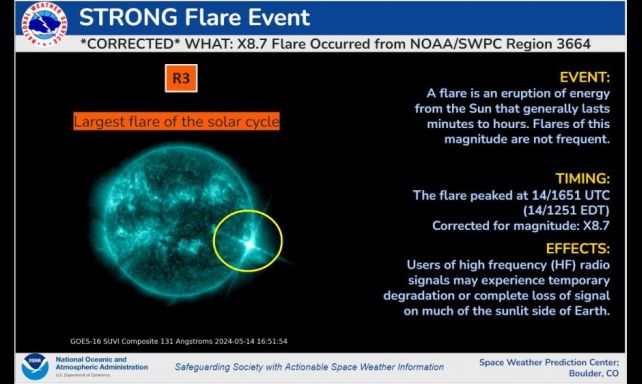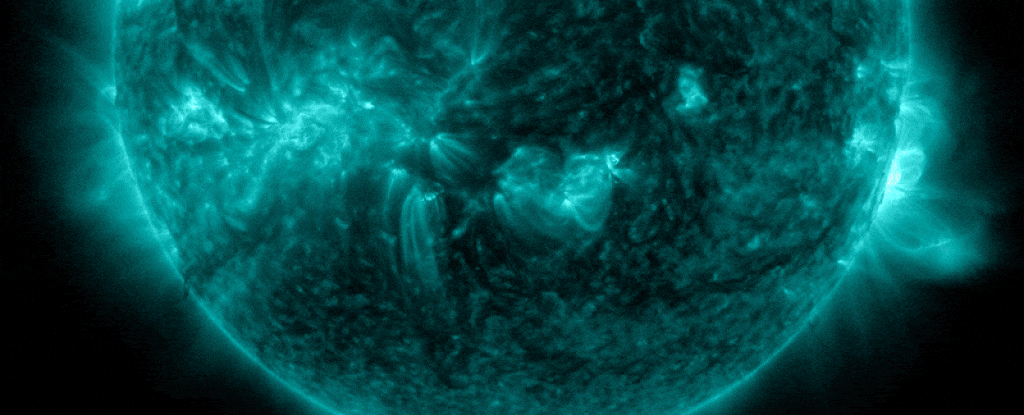Products You May Like
A solar flare measured at X8.7 on the strength scale just emerged from AR 3664, the sunspot region responsible for last weekend’s solar storms that sparked vivid auroras.
That’s the most powerful solar flare of the current cycle, absolutely the most powerful since 2017, and comfortably within the top 20 solar flares ever measured.
As AR 3664 made its way toward the edge of the Sun’s disk, it wasn’t just the X8.7 flare on May 14 that erupted from the solar limb. On May 15, an X3.4 flare followed suit, suggesting that the giant sunspot region is going to continue its party on the far side of the Sun, out of view from Earth.
X-class flares are the most powerful eruptions our Sun can manage.
Because of the position of both flares, further solar storms from AR 3664 are unlikely. But a sunspot region that is just beyond the limb on the opposite side of the Sun, about to emerge from the far side, spat out an X2.9 flare, also on May 15 – which means we could be in for more interesting times here on Earth in the days ahead.

The most recent solar flare more powerful than the X8.7 was recorded on 10 September 2017, clocking in at X11.88. At the time, however, it was logged at X8.2; the revised strength was reached after removing the scaling applied by NOAA’s Space Weather Prediction Center (SWPC).
This means that the science quality data for the recent flare could reveal an even greater strength than the initial SWPC report.
This uptick in solar activity could mean we’re finally reaching solar maximum. This is the peak in the Sun’s 11-year activity cycle, where it displays the greatest amount of sunspot activity, and the associated flares and coronal mass ejections.
The solar cycle is not well understood, but we know that it manifests in the solar magnetic field. At solar maximum, the Sun’s magnetic poles switch places, coinciding with a peak in other solar activity. Sunspots are regions on the solar surface where the Sun’s magnetic field is temporarily more powerful than the surrounding regions.
When sunspot magnetic field lines tangle, snap, and reconnect, they release a powerful burst of energy. That’s a solar flare. Sometimes this is accompanied by an ejection of huge blobs of solar particles tangled up with magnetic fields. That’s a coronal mass ejection.
When this material reaches Earth’s magnetosphere, the resulting interaction of particles produces auroras and other effects, such as power surges and disruptions in communications.
Solar cycles can vary in length, so it’s difficult to predict when maximum will occur. Solar maximum can only be confidently declared after the fact, when scientists have been able to compile the data to identify a distinct peak in activity, and the start of the subsidence to solar minimum.
However, solar maximum is predicted to take place by July of next year, so we may very well be in the throes of it right now.
frameborder=”0″ allow=”accelerometer; autoplay; clipboard-write; encrypted-media; gyroscope; picture-in-picture; web-share” referrerpolicy=”strict-origin-when-cross-origin” allowfullscreen>
This solar cycle has been far more active than original official predictions, which is great news for solar scientists and aurora chasers. It’s giving us a lot more data to try to understand why solar cycles behave the way they do – which in turn could help us better predict the timings of solar maxima and minima, as well as the strength of future solar cycles.
Since solar weather can affect us here on Earth, being able to predict it more accurately will give us an excellent tool for bracing ourselves – protecting power grids against the surges that result from currents in the atmosphere, for example, and preparing for communications and radio frequency blackouts.
The sunspot region about to emerge onto the solar disk is suspected to be AR 3655, which we saw rotate out of view on May 4. On its return, it will be given a new number, in keeping with the sunspot region numbering system.
Here’s hoping we might have a few more solar storm spectacles to come with it – with none of the major disruptions.
